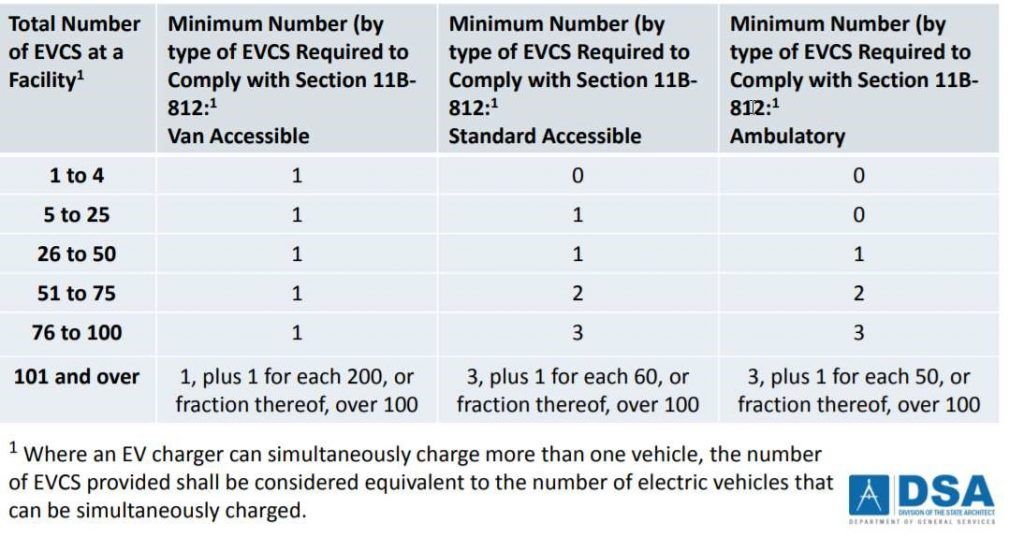Sales of electric and hybrid vehicles are on the rise, as is the need for electric vehicle charging stations (EVCS) to charge those vehicles. More and more, we see hotels, hospitals, theaters, shopping centers, stadiums, apartment communities, and other commercial establishments that provide EVCS as a service to their guests, patients, and residents.
Although there are no federal standards for EVCS accessibility, provisions are being proposed. Consistent with general guidance provided by the U.S. Access Board, if your facility provides EVCS for use by the general public then it must also be accessible to individuals with disabilities.
California's Standards for EVCS Accessibility
In California, if you provide EVCS for use by the general public, a number of those charging stations must be accessible to individuals with disabilities. If you are thinking of installing EVCS in your development, you should be aware that the accessibility requirements for EVCS are different than the accessibility requirements for parking, both of which are detailed in the California Building Code (CBC).
In addition, some California cities have local zoning codes that specify requirements for EVCS, and developers and commercial property owners in those jurisdictions will need to comply with those codes, as well.
While we have not seen litigation over the accessibility of EVCS, it is only a matter of time before the plaintiffs' bar becomes aware of the California Building Code requirements and begin to file lawsuits against developers that fail to follow the guidelines.
California's Regulations for EVCS Accessibility
Few know that California's accessibility regulations for EVCS are in the 2016 California Building Code (CBC), and went into effect on January 1, 2017. The regulations supersede and expand upon California's little-known "Interim Disabled Access Guidelines for Electric Vehicle Charging Stations" created in 1997.
The CBC accessibility regulations include both scoping requirements (what type of EVCS and how many) and technical requirements (where to locate EVCS, and how to make them accessible). These particulars are important to retail, hotel, hospital, and apartment communities that are under development or renovation.
Scoping Requirements
The number and type of accessible EVCS required is determined by the total number of EVCS at a facility. When new EVCS are added to a site with existing EVCS, the total number of new and existing EVCS is used to determine the number of accessible EVCS.
The table below, from the California Building Code (11B-228.3), sets forth these scoping requirements.
CBC 11B-228.3 Scoping TABLE 11B-228.3.2.1

Technical Requirements
Technical requirements apply only to new and altered EVCS; existing EVCS do not have to be altered to meet the new technical requirements. The table above includes the minimum number of EVCS for three of the four types of accessible EVCS under the CBC's accessibility regulations: van accessible, standard accessible, and ambulatory. Each type of charging station has specific technical requirements, which are outlined in CBC 11B-812. The fourth type, "drive up," is analogous to a motor fuel pump island at a gas station, and is also included in CBC 11B-812.
The technical requirements include accessible aisles, accessible routes, and electric vehicle charger requirements.
Technical provisions include specific requirements for signage. EV charging time limits can be applied to all users, including disabled users. Vehicles displaying accessible placards or license plates cannot park for unlimited periods of time at accessible EVCS, if the signage is in accordance with local ordinances.
Primary function areas must be accessible
Where transient parking or vehicle storage is the primary purpose or sole use of the facility, the installation of electric vehicle charging stations is considered a "primary function area" and to the maximum extent feasible, the path of travel to the charging stations, including restrooms, pay telephones and drinking fountains, would be required to be readily accessible to and useable by persons with disabilities. Additional attention to upgrading non-compliant paths of travel outside the project area would be required, under the 20% "disproportionality test."
Moving forward
If you intend to (or are requested to) install electric vehicle charging stations at your property, you need to consider whether they are accessible to persons with disabilities. Since the proposed scoping and technical requirements are highly technical and complex, you should consult the experts before you design or install electric vehicle charging stations.
The content of this article is intended to provide a general guide to the subject matter. Specialist advice should be sought about your specific circumstances.
